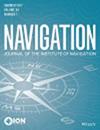Probabilistic Map Matching for Robust Inertial Navigation Aiding
IF 2
3区 地球科学
Q1 ENGINEERING, AEROSPACE
引用次数: 3
Abstract
Robust aiding of inertial navigation systems in GNSS-denied environments is critical for the removal of accumulated navigation error caused by the drift and bias inherent in inertial sensors. One way to perform such an aiding uses matching of geophysical measurements, such as gravimetry, gravity gradiometry or magnetometry, with a known geo-referenced map. Although simple in concept, this map-matching procedure is challenging: The measurements themselves are noisy, their associated spatial location is uncertain, and the measurements may match multiple points within the map (i.e., non-unique solution). In this paper, we propose a probabilistic multiple-hypotheses tracker to solve the map-matching problem and allow robust inertial navigation aiding. Our approach addresses the problem both locally, via probabilistic data association, and temporally by incorporating the underlying platform kinematic constraints into the tracker. The estimated platform position from the output of map matching is then integrated into the navigation state using an unscented Kalman filter. Additionally, we present a statistical measure of local map information density — the map feature variability — and use it to weight the output covariance of the proposed algorithm. The effectiveness and robustness of the proposed algorithm are demonstrated using a navigation scenario involving gravitational map matching.鲁棒惯性导航辅助的概率映射匹配
摘要在gnss缺失环境下,对惯性导航系统进行鲁棒辅助是消除惯性传感器固有漂移和偏置导致的累积导航误差的关键。执行这种辅助的一种方法是将地球物理测量(如重力测量、重力梯度测量或磁力测量)与已知的地理参考地图相匹配。虽然概念上很简单,但这种地图匹配过程具有挑战性:测量值本身是有噪声的,它们相关的空间位置是不确定的,并且测量值可能匹配地图中的多个点(即非唯一解)。在本文中,我们提出了一种概率多假设跟踪器来解决地图匹配问题,并允许鲁棒惯性导航辅助。我们的方法通过概率数据关联解决了局部问题,并通过将底层平台运动学约束合并到跟踪器中来解决临时问题。然后使用无气味卡尔曼滤波器将地图匹配输出的估计平台位置整合到导航状态中。此外,我们提出了局部地图信息密度的统计度量-地图特征可变性-并用它来加权所提出算法的输出协方差。通过重力图匹配的导航场景验证了该算法的有效性和鲁棒性。
本文章由计算机程序翻译,如有差异,请以英文原文为准。
求助全文
约1分钟内获得全文
求助全文
来源期刊

Navigation-Journal of the Institute of Navigation
ENGINEERING, AEROSPACE-REMOTE SENSING
CiteScore
5.60
自引率
13.60%
发文量
31
期刊介绍:
NAVIGATION is a quarterly journal published by The Institute of Navigation. The journal publishes original, peer-reviewed articles on all areas related to the science, engineering and art of Positioning, Navigation and Timing (PNT) covering land (including indoor use), sea, air and space applications. PNT technologies of interest encompass navigation satellite systems (both global and regional), inertial navigation, electro-optical systems including LiDAR and imaging sensors, and radio-frequency ranging and timing systems, including those using signals of opportunity from communication systems and other non-traditional PNT sources. Articles about PNT algorithms and methods, such as for error characterization and mitigation, integrity analysis, PNT signal processing and multi-sensor integration, are welcome. The journal also accepts articles on non-traditional applications of PNT systems, including remote sensing of the Earth’s surface or atmosphere, as well as selected historical and survey articles.
 求助内容:
求助内容: 应助结果提醒方式:
应助结果提醒方式:


